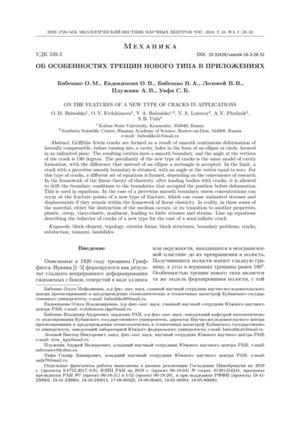Об особенностях трещин нового типа в приложениях
УДК
539.3DOI:
https://doi.org/10.31429/vestnik-16-3-28-32Аннотация
Трещины Гриффитса-Ирвина формируются как результат гладкого непрерывного деформирования сжимаемых с боков, отверстий в виде эллипса или окружности, находящихся в неограниченной пластине до их превращения в полость. Получившиеся полости имеют гладкую границу, а угол в вершинах трещины равен 180 градусам. Особенностью трещин нового типа является та же модель формирования полости, с той разницей, что вместо эллипса принимается прямоугольник. В пределе получается трещина с кусочно-гладкой границей, с углом в вершине равным нулю. Для этого типа трещин формируется различный набор уравнений, в зависимости от удобства исследований. В рамках линейной теории упругости допускается после нагружения тел с трещинами снос граничных условий на границы, занимавшие положение до деформации. Это используется в уравнениях. В случае кусочно-гладкой границы у трещин нового типа в точках излома границ могут возникать концентрации напряжений, способных вызывать неограниченные напряжения и перемещения, если оставаться в рамках линейной упругости. В реальности в этих зонах материала либо происходит разрушение среды, либо ее переход в иную реологию, пластическую, ползучести, вязкоупругую, нелинейную, приводящую к конечным напряжениям и деформациям. Строятся уравнения, описывающие поведение трещин нового типа для случая полубесконечной трещины.
Ключевые слова:
блочный элемент, топология, внешние формы, блочные структуры, граничные задачи, трещины, субдукция, цунами, оползниИнформация о финансировании
Отдельные фрагменты работы выполнены в рамках реализации Госзадания Минобрнауки на 2019 г. (проекты 9.8753.2017/8.9), ЮНЦ РАН на 2019 г. (проект 00-18-04) № госрег. 01201354241, программ президиума РАН №7 (проект 00-18-21) и I-52 (проект 00-18-29), и при поддержке РФФИ (проекты 19-41-230003, 19-41-230004, 19-48-230014, 17-08-00323, 18-08-00465, 18-01-00384, 18-05-80008).
Библиографические ссылки
- Babeshko V.A., Babeshko O.M., Evdokimova O.V. A New Type of Cracks Adding to Griffith-Irwin Cracks // Doklady Physics. 2019. Vol. 64. No. 3. P. 102–105. DOI: 10.1134/S1028335819030042
- Babeshko V.A., Evdokimova O.V., Babeshko O.M. On the possibility of predicting some types of earthquake by a mechanical approach // Acta Mechanica. 2018. Vol. 229. Iss. 5. P. 2163–2175. DOI: 10.1007/s00707-017-2092-0
- Babeshko V.A., Evdokimova O.V., Babeshko O.M. On a mechanical approach to the prediction of earthquakes during horizontal motion of litospheric plates // Acta Mechanica. 2018. Vol. 229. Iss. 10. P. 4727–4739. DOI: 10.1007/s00707-018-2255-7
- Griffith, A. The Phenomena of Rupture in Solids // Trans. Roy. Soc. A. 1920. Vol. 221. P. 163–197. DOI: 10.1098/rsta.1921.0006
- Irwin G. Fracture dynamics // Fracture of metals, ASM, Cleveland. 1948. P. 147-166.
- Черепанов Г.П. Механика хрупкого разрушения. М.: Наука. 1974. 640 с. [Cherepanov, G.P. Mekhanika khrupkogo razrusheniya [A mechanics of brittle fracture]. Nauka, Moscow, 1974. (In Russian)]
- Морозов Н.Ф. Математические вопросы теории трещин. М.: Наука. 1984. 256 с. [Morozov, N.F. Matematicheskie voprosy teorii treshchin [Mathematical issues in crack theory]. Nauka, Moscow, 1984. (In Russian)]
- Rice 8.j.R. Elastic fracture mechanics concepts for interface cracks // Trans. ASME. J. Appl. Mech. 1988. Vol. 55. P. 98–103.
- Qu J. Interface crack loaded by a time-harmonic plane wave // Int. J. of Solids and Struct. 1994. Vol. 31. Iss. 3. P. 329–345.
- Партон В.З., Борисковский В.Г. Динамика хрупкого разрушения. М.: Машиностроение, 1988. 240 с. [Parton, V.Z., Boriskovskiy, V.G. Dinamika khrupkogo razrusheniya [The dynamics of brittle fracture]. Mashinostroenie, Moscow, 1988. (In Russian)]
- Александров В.М., Сметанин Б.И., Соболь Б.В. Тонкие концентраторы напряжений в упругих телах. М.: Наука, 1993. 224 с. [Aleksandrov, V.M., Smetanin, B.I., Sobol', B.V. Tonkie kontsentratory napryazheniy v uprugikh telakh [Thin stress concentrators in elastic bodies]. Nauka, Moscow, 1993. (In Russian)]
- Kirugulige M.S., Tippur H.V. Mixed-mode dynamic crack growth in functionally graded glass-filled epoxy // Exp Mech. 2006. Vol. 46. Iss. 2. Р. 269–281.
- Rangarajan R., Chiaramonte M.M., Hunsweck M.J., Shen Y., Lew A.J. Simulating curvilinear crack propagation in two dimensions with universal meshes // Int. J. Numer. Meth. Engng. 2014. Vol. 102. Iss. 3–4. Р. 632–670.
- Huang Y., Gao H. Intersonic crack propagation - Part II: Suddenly stopping crack // J. Appl. Mech. 2002. Vol. 69. Р. 76–80.
- Krueger R. Virtual Crack Closure Technique: History, Approach, and Applications // Appl. Mech. Rev. 2004. Vol. 57. Р. 109–143.
Скачивания

Загрузки
Даты
Поступила в редакцию
Принята к публикации
Публикация
Как цитировать
Лицензия
Copyright (c) 2019 Бабешко О.М., Евдокимова О.В., Бабешко В.А., Лозовой В.В., Плужник А.В., Уафа С.Б.

Это произведение доступно по лицензии Creative Commons «Attribution» («Атрибуция») 4.0 Всемирная.


